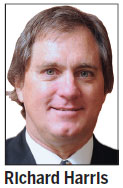MTR is not asleep at the wheel, but most likely asleep in its bed
Updated: 2014-05-16 05:07
By Richard Harris(HK Edition)
|
|||||||
Kowloon never used to be the "Dark Side". In the early 1970s it was a joy to have nice steady ride across the harbor on the Star Ferry. It cost 10 cents to cross on a second-class ticket. You didn't even have to climb the steps - even if you did exit feeling somewhat oily!
The cross-harbor tunnel was built in 1972, allowing buses to cross the harbor during all but a typhoon No 8. Emergency vehicles were completely unhindered. Then, work on the MTR started and I remember talking to a senior government official who mused that maybe we don't need the Star Ferry now that cross-harbor connections are open around the clock. But it has survived almost exclusively for tourists although reclamations have made it a much shorter journey.
I worked as an engineer on the first MTR line built from Central to Tsuen Wan. It is interesting to look back to see that this was the critical route in those days. I remember climbing down flights of step ladders to the muddy track base of Jordan Station and later working on the magnificent and enormous Taikoo Cavern, which is now hidden to all but a few keen eyes. It was blasted out of solid rock over 100 feet underground. These were spectacular projects that were largely completed on time and within their budgets.

But each generation does better and current ambitious MTR projects are even more spectacular. They are being undertaken all at once. The Round Island line, the Sha Tin to Central Line and the high-speed railway to the mainland were all needed yesterday. This is strange - as so much effort and costs has been expended by the government on the unnecessary bridge to Zhuhai.
I am not at all surprised by the delay in the MTR's high-speed railway out of West Kowloon station. A good deal of first-hand experience about ground conditions has been lost with the edging out, or retirement, of the (often expatriate) engineers who built the original Central to Tsuen Wan line. The excavation is perhaps the biggest attempted in Hong Kong in the worst possible ground conditions. The geology is horrendous with reclamation work, harbor sediments and bedrock to deal with. There are also double the people living in Hong Kong now. These people have to be drilled, excavated and concreted around - while creating the least havoc.
When the project is finished it will be fantastic and critical to our links with the mainland. There will undoubtedly be a steward's enquiry about the sudden two-year delay. And also something of a whitewash, with the head of the MTR (who is leaving anyway) becoming the lightning rod for all the failures in communication. The engineers and contractors should take some blame - the MTR is, after all, the immediate client. The government is underwriting the cost and needs to ask itself: Why wasn't it started earlier? And do we have the quality people from all around the world working on projects as we had on the first MTR?
However, it is unfair to accuse the MTR of being asleep at the wheel because they were more likely to have been asleep in their beds!
Hong Kong International Airport was built promising the people of Hong Kong a fast rail link - despite the distance. However, as any frequent traveler knows, the delays in air travel in Asia are getting worse. China's air traffic corridors are at capacity and passengers have to get their flights earlier in the day to stay on time. By evening, the delays are increasingly lengthy, yet the Airport Express stops running after 12:30 am. Passengers have to land before 11:30 pm to get a train. Is it not time, after 17 years of operating the Airport Express, for the MTR to understand that because this is such a critical service to our economy, it should run for 24 hours?
So maybe the real blame that should be directed at the MTR is whether they are actually providing a relevant service?
The author is a pioneer of the modern investment management industry in Asia and is Chief Executive of Port Shelter Investment Management in Hong Kong.
(HK Edition 05/16/2014 page9)